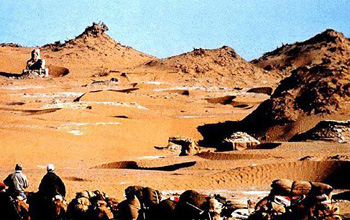| Legole.Com Discover china. Explore the beauty and wonder of the land, people, and culture of China. |
 |
|
|
 |
 The ancient city of Niya, another Pompeii-like city on the Silk Road, lies 150 km from Minfeng, an oasis county in the Taklimakan Desert. The ruins are believed to be the ancient Kingdom of Jingjue, one of the oasis states recorded in the Chinese Han Dynasty chronicles. However, the city vanished circa 500 to 1000 AD. In 1901 British explorer Aurel Stein rediscovered the ruins, made some astonishing finds, and acquired many artifacts. In 1993 and 1995, two Sino-Japanese expeditions unearthed previously undiscovered ruins. At the heart of Taklimakan Desert, some existing wooden structures, including houses with courtyards, stables, graves, and clay Buddhist stupas, and even a bridge were found. In the residential quarter, the team also found jewelry, bronze mirrors, coins, arrowheads, household utensils and other items. Wooden tablets written in the long dead Kharoshthi writings were considered very important finds. Preserved beneath the sand, some naturally mummified corpses resting in hollowed-out tree trunks were excavated in the city ruins too. Those corpses together with other findings indicate the city was once a place where Chinese met with Indians and Europeans. The city was not only a trading post and but also a culture exchang post. Although evidence indicates that it was the encroaching desert that destroyed the once prosperous city, enemy invasions might also have contributed to its demise. The ancient city of Niya, another Pompeii-like city on the Silk Road, lies 150 km from Minfeng, an oasis county in the Taklimakan Desert. The ruins are believed to be the ancient Kingdom of Jingjue, one of the oasis states recorded in the Chinese Han Dynasty chronicles. However, the city vanished circa 500 to 1000 AD. In 1901 British explorer Aurel Stein rediscovered the ruins, made some astonishing finds, and acquired many artifacts. In 1993 and 1995, two Sino-Japanese expeditions unearthed previously undiscovered ruins. At the heart of Taklimakan Desert, some existing wooden structures, including houses with courtyards, stables, graves, and clay Buddhist stupas, and even a bridge were found. In the residential quarter, the team also found jewelry, bronze mirrors, coins, arrowheads, household utensils and other items. Wooden tablets written in the long dead Kharoshthi writings were considered very important finds. Preserved beneath the sand, some naturally mummified corpses resting in hollowed-out tree trunks were excavated in the city ruins too. Those corpses together with other findings indicate the city was once a place where Chinese met with Indians and Europeans. The city was not only a trading post and but also a culture exchang post. Although evidence indicates that it was the encroaching desert that destroyed the once prosperous city, enemy invasions might also have contributed to its demise. |
 |
|
|
 |
|
